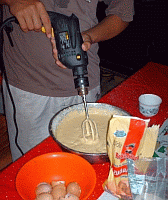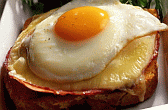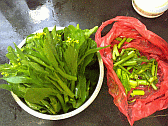|
|
| How
Do I Make ... ? |
Yorkshire
Pudding |
|
Yorkshire Pudding is a traditional part
of British Sunday Lunch and has been for centuries.
They come in two forms: large circles that sometimes
have filling; or small individual puddings added to
the plate.
Here we also give recipes for:
Toad in the Hole
and
Yorkshire Pudding Meals
Recipe Source:
 |
Dawn Copeman, Yorkshire, England |
|
|
| Websites: TimeTravel-Britain.com |
| Dawn is a keen chef and knows a
great deal about traditional British cooking.
As well as providing us with this Yorkshire Pudding
recipe, her website also gives history and recipes
for other culinary delights, such as: 'Fat Rascals',
Pontefract Cakes, Parkin, and Yorkshire Curd Tart. |
|
| |
|
|
| 1. Let's get started:- Yorkshire
Pudding |
| |
|
Ingredients:
• 4oz or 1 cup all purpose flour
• Same amount by volume of water or whole
milk
• 2 eggs
• 1/2 stick lard or dripping (4oz)
• A pinch of salt
• An eight inch round or square tin for
a large pudding, or small tins for individual
puddings. |
 |
Yorkshire Pudding Method
When making Yorkshire pudding, ensure the batter
is cold and the oven is very hot! Ensure you've heated
the dripping in the pan before you put the batter
in.
Sieve the flour a couple of times before you begin.
Put all the dry ingredients in a bowl and mix thoroughly.
Pre heat the oven at 230°C, 450°F or Gas Mark 8. Put
the dripping into the tin(s) and let it get very hot.
'Gas Mark 9 or full blast is better (Jonno)'.
Mix flour and salt in a bowl, make a dip in the middle
and add the eggs.
Stir with a wooden spoon, gradually adding milk or water,
until all the flour has been absorbed.
Add remaining liquid and beat well. It should be fairly
runny, similar in consistency to single cream.
Pour batter into hot dripping in the tins.
Bake a large pudding for 30 mins, small puddings for
20 mins.
Dawn's Dad
As a variation on this try my dad's Christmas Yorkshire
puddings. All year my mum made the Yorkshire puddings
for our meals, except on Christmas day, when my dad
made the Christmas lunch. It took me years to persuade
him to tell me what made his puddings taste so fantastic,
and here is his secret ingredient - just add a tablespoon
of sage and onion stuffing mix to the dry ingredients,
and add a drop more liquid (about a tablespoon) to compensate.
Go on, try it.
Comment by Jonno: It's all About "Heat"
The most essential ingredient is an extremely hot oven!
By this I mean that you cannot get a modern oven hot
enough! I was very fortunate to once own a 1932 oven
made by Leisure Company, which went up as high as gas
mark 15! Using this - very well pre-heated (Including:
trays, fat or dripping), my Yorkshires would rise between
6 and 10 inches under these conditions, and be light
and fluffy. I have no idea what those measurements are
in French? My cooking time was also reduced to around
8-10 minutes.
Today if you ask to buy an oven which goes as high as
gas mark 15, the salesman will think you are mad, and
treat you with disdain. For perfect individual Yorkshire
Puddings, this high temperature is obligatory, but not
so for the larger version. I drilled out the gas pipes
and hob vents on my later gas mark 9 only cooker - and
it performed admirably henceforth.
In China, where there are no ovens worth mentioning,
and gas mark 4 on any household hob is an achievement
of hot science. Therefore you basically need to buy
one of the industrial hobs all good restaurant kitchens
have. These things make a 'whooshing' sound when turned
up full blast - I'm sure you have heard them.
To make this into a suitable 'oven', put 6oz of beef
dripping into a large wok, insert a stand, place your
trays on this, and fill with the remaining dripping
(Or fat from the cooked meat). Cover and turn-up to
full blast. Leave this for several minutes, whilst donning
protective clothing.
Ensure there is still hot fat remaining in all the individual
pudding trays, and add the cold Yorkshire mix. Cover
immediately and consider removing the protective clothing.
If this is your first time, then leave it on! These
Yorkshires should be cooked to perfection in around
7-minutes - or when the lid no longer rests on the wok.
Tip:
If your roast potatoes are not doing too well, then
remove the stand from the wok and let them take their
chances in the remaining hot oil - works a treat.
Tips and Tricks
1. Get everything as hot as possible,
excepting the batter mix
History and interesting facts - By Dawn Copeland
Yorkshire pudding.
The word pudding conjures up images of desserts, cream,
sweetness and whilst Yorkshire puddings can be eaten
as a dessert, they are mainly a savoury dish. Confused?
I'll explain.
Yorkshire puddings are made from a batter, similar to
pancakes. They have been in existence since the middle
ages when they were made by placing the tin containing
the batter underneath the meat roasting on a spit. The
reasoning being that the dripping fat would add more
flavour to the pudding. They were at that time known
as Dripping Puddings. Incidentally, if Yorkshire puddings
weren't being made, a tin would be placed underneath
the meat to catch the fat. Once this fat had cooled,
it was called Dripping and spread onto bread as a savoury
filling. Tubs of dripping can still be bought in butcher
shops today. As a child I regularly ate dripping sandwiches
and they taste better than they sound.
'Jonno: And so did I.'
The modern recipe has its origins in a recipe developed
in the eighteenth century by a cook named Hannah Glasse,
and from that point on dripping puddings became known
as Yorkshire puddings.
There are two varieties of Yorkshire pudding: small,
individual ones -- often known as popovers, which
are eaten alongside the meat -- and flat, large ones,
the size of a dinner plate. The traditional way to
eat a Yorkshire pudding is to have a large, flat one
filled with gravy and vegetables as a starter. Then
when the meal is over, any unused puddings should
be served with jam or ice-cream as a dessert. This
is certainly the way we ate them when I was growing
up and delicious they were too, both as starter and
dessert.
Yorkshire pudding batter is the main ingredient in that
famous and confusing British dish, Toad in the Hole.
The toad simply means the meat filling. Originally it
was a means of stretching expensive meat so that it
would feed more people, (there's an 18th century recipe
for toad in the hole using fillet steak), then the toad
became a means of using up left-over meat, and now the
toad is sausages.
Toad in the Hole
Thanks to Dawn above for introducing this British culinary
odyssey.
This is simply a large Yorkshire Pudding cooked in a
large oblong tray, with sausages added.
Recipe and Cooking:
Put oil into a non-heated roasting tray with 4 oz lard
or meat dripping as above. Add Butcher's pork sausages,
pierced and un-linked; and a double row is usual. Place
in a pre-heated oven at gas mark 7 or 8, and cook for
about 10 minutes - allowing the sausages to part cook
in the oil. Make the Yorkshire mix as above, and add
to the hot tin, setting sausages in place as you pour
in the liquid. Cook for a further 30 minutes, or until
golden brown.
It would be most reasonable to add additional seasoning
to this mix, such as a pinch of: black pepper, thyme,
sage, or fresh coriander leaves.
Serve from the dish as a main course; although a little
Italian red wine compliments this very well.
Yorkshire Pudding Meal
or "Yorkies"
"Yorkies" can be made in a variety of forms,
including muffin size bowls and large high sided baking
trays. They may be accompanied by a whole host of different
sauces, both sweet and savory, including: gravy, cheese
sauce, seafood with white sauce, apples and cream, ice
cream and jam (preserves.)
However, most Yorkies are savory as introduced by British
Pubs in the 90's. They are intended to be a quick and
complete meal, so often contain things such as steak
and kidney with potatoes, and other vegetables.
To make these, think simplicity. Make a Yorkie base
as described above, and when serving; add a thick meat
stew, casserole, or sweet version of your choice. This
would be exactly how to serve the left-over beef casserole
or chicken curry you froze last week. Obviously, you
heat the casserole to a simmer first, and add this to
the Yorkie moments before serving to your guests.
This is also a great way to serve Poutine Quebecoise
= chips with gravy and cheese. Add cooked chips (large
French Fries) to the Yorkie base, then a good portion
of fairly thick gravy. Chicken gravy just about hits
the spot here, as we are not looking for an overriding
taste, just a complementary one. Grate some cheese over
the top (Cheddar works very well), and toast for a minute
- or simply serve without toasting and let it meld.
|
|
|
This information is as supplied by ourselves, and ably
supported by our friends and various internet portals.
In particular we wish to thank Dawn Copeland and our
friends at TimeTravel-Britain.com
for their invaluable support and advice |
|
| Search
this Website |
|
|
| Our
Friends |

Recipes, Chef's Tips, Food, Cookery and Wine holidays
all over the world |
| Boy
Cooking |
 |
| Béchamel Related |






|
| Descriptions |









|
| Chinese Recipes |
 |
|